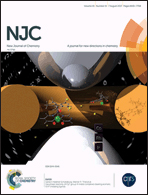Rational design, preparation and adsorption study of a magnetic molecularly imprinted polymer using a dummy template and a bifunctional monomer
Abstract
In this study, a molecular docking method and solvation model in computer simulation were applied to simultaneously screen a dummy template and a bifunctional monomer in the rational design of a magnetic molecularly imprinted polymer. According to the results of computer simulation, quercetin as a dummy template and methacrylic acid and 4-vinylpyridine as bifunctional monomers could form hydrogen bonds and π–π interaction in a pre-assembly system, which contributes to the formation of highly selective molecular recognition sites and reduces the influence of the solvent on the system. Magnetic molecularly imprinted polymers of a bifunctional monomer as well as those of a monofunctional monomer were prepared and systematically evaluated via scanning electron microscopy, infrared spectroscopy, and vibrating sample magnetometry as well as adsorption kinetics, adsorption isotherms, and adsorption selectivity experiments. All the results strongly indicated that quercetin was suitable to be used as a dummy template, and the bifunctional monomer polymer showed good selectivity and affinity to the target molecule zearalenone, which can be applied in the extraction and purification of real samples. This novel study provides complete and valuable information on the rational design, preparation, and adsorption properties of a magnetic molecularly imprinted polymer using a dummy template and bi-functional monomers.



 Please wait while we load your content...
Please wait while we load your content...